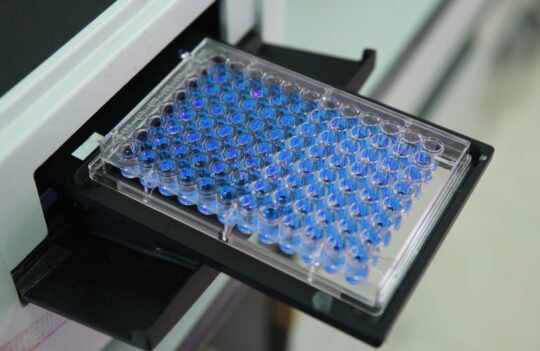 Peptide synthesis
Peptide synthesis
Do cosmetic peptides have proven efficiency in preventing and treating skin and hair conditions?
The beneficial properties of peptides have been known for more than a century. But only in the last decades has this potential been harnessed to prevent and treat skin and hair conditions. Due to their inexpensive manufacturing process, cosmetic peptides are increasingly included in personal care products to generate higher-value formulations.
The discovery of cosmetic peptides
For more than a century, scientists have grasped the potential of peptides for countless applications. Their therapeutic usefulness was first discovered in the early 1920s by Canadian researchers using pancreatic extracts of animals to treat diabetes.
These extracts contained high doses of insulin, which became the first life-saving peptide in clinical use.
But it was only after the development of solid-phase synthesis processes that the use of peptides for non-therapeutic applications became popular.
Presently, the incorporation of cosmetic peptides in skincare and hair care products is becoming increasingly popular.

Presently, the incorporation of cosmetic peptides in skincare and hair care products is becoming increasingly popular.
This interest was first stirred by the discovery of the human copper-binding peptide GHK-Cu by Loren Pickart in 1973. GHK-Cu is small tripeptide complex that occurs naturally in human plasma. Researchers found that this peptide was also released from tissues in case of injury, indicating its potential protective and regenerative properties.
In the late 1980s, the first copper peptide was incorporated into skincare products. But even after this first step, the development of cosmetic peptides progressed at a slow pace. This strenuous progress only started shifting after the discovery of palmityl pentapeptide-4.
This peptide was initially developed for use in wound healing applications. But researchers soon noticed that small doses of this peptide were effective in preventing premature aging and improving skin elasticity, properties that quickly captured the interest of the cosmetic industry.
Since then, many small peptides were found to have effects on the synthesis of the extracellular matrix, pigmentation, skin immunity and inflammation. From a dermatological point of view, these molecules became invaluable to prevent and treat chronic skin conditions such as melasma – a dark skin discoloration – and autoimmune dermatological disorders such as alopecia areata – progressive hair loss.
The topical application of these formulations is also recurrently used to stimulate collagen production (anti-aging), wound healing and promote wrinkle smoothing. Some peptides also possess antioxidative and antimicrobial properties, which also makes them suitable for inclusion in food formulations to increase the shelf-life of these products.
Classification of cosmetic peptides
Protective and regenerative cosmetic peptides included in common formulations can be classified as signal peptides, carrier peptides, neurotransmitter inhibitor peptides, and enzyme inhibitor peptides. Independently from their classification, all these compounds are expected to be able to cross the skin barrier and thus they should ideally have the following physicochemical properties:
- Molar mass < 500 Da
- Log of the partition coefficient for octanol/water (LogP) between 1-3
- Melting point below 200 °C
- Water solubility > 1 mg/ml
A few examples of cosmetic peptides with proved efficacy can be found on the table below:
| Classes of cosmetic peptides | Name | Sequence | Demonstrated effects |
|---|---|---|---|
| Signal peptides | Palmitoyl Tripeptide-1 | Pal-Gly-His-Lys | Anti-wrinkle |
| Palmitoyl Tripeptide-3/5 | Pal-Lys-Val-Lys bistrifluoroacetate salt | Wound healing
Anti-wrinkle |
|
| Palmitoyl Pentapeptide-4 | Pal-Lys-Thr-Thr-Lys-Ser-OH | Improved skin elasticity
Anti-wrinkle |
|
| Palmitoyl Hexapeptide-12 | Pal-Val-Gly-Val-Ala-Pro-Gly | Improved skin elasticity, tone and firmness | |
| Carrier peptides | Copper tripeptide (GHK-Cu) | Cu-Gly-l-His-l-Lys | Promotes skin and hair regeneration and growth |
| Manganese tripeptide (GHK-Mn) | Mn-Gly-l-His-l-Lys | Reduces hyperpigmentation | |
| Neurotransmitter inhibiting peptides | Acetyl Hexapeptide-3 | N-acetyl-Glu-Glu-Met-Gln-Arg-Arg-NH2 | Anti-wrinkle
Skin moisturizer |
| Pentapeptide-18 | H-Ala-Gly-Leu-Phe-Tyr-OH | Botox-like effects
Anti-wrinkle Skin moisturizer Improved skin firmness and tone |
|
| Pentapeptide-3 | H-Gly-Pro-Arg-Pro-Ala-OH | Anti-wrinkle
Increased skin smoothness |
|
| Tripeptide-3 | H-Gly-His-Arg-OH | Anti-wrinkle | |
| Enzyme inhibitor peptides | Soybean Peptides | Not defined | Anti-aging
Sun protection |
| Structural peptides | Keratin-Based Peptides | Not defined | Skin and hair moisturizer
Improves skin firmness |
Beyond the dermatological applications – antimicrobial cosmetic peptides
In humans and animals, the skin is the first line of defense against pathogenic microorganisms that can cause dermatological diseases. Besides providing a physical barrier, the skin of most animals is also usually covered with layers of secretions containing antimicrobial peptides.
These molecules can interact with skin microorganisms in multiple ways, either by killing, suppressing their growth or acting as immunomodulators. These molecules are also naturally suited for topical application and, thus, can easily be included in ointments, lotions, shampoos, creams or in wound dressings to prevent infections.
Due to their intended use for topical applications, these molecules do not need to cross the skin barrier and thus, they are generally larger than its cosmetic counterparts. Moreover, many of them have been isolated from natural sources and, thus, can be effectively used without further chemical modifications.
Many of these antimicrobial peptides have confirmed efficiency to treat and prevent several well-known skin pathogens and conditions:
- Folliculitis caused by Staphylococcus aureus can be treated with the following peptides: UBI (sequence: RAKRRMQY), TsAP2 (sequence: FLGMIPGLIGGLISAFK), Ranalexin (sequence: FLGGLIKIVPAMICAVTKKC), Plc-2 (sequence: KHVGKAALTHYL), among others
- Seborrheic dermatitis caused by Malassezia furfur can be treated with the following peptides: P5 (sequence: KWKKLLKKPLLKKLLKKL-NH2) and Rev-NIS (sequence: ELLKAVRLIK)
- Atopic eczema caused by Malassezia sympodialis can be treated with the following peptides: Arg9 (sequence: RRRRRRRRR), pVEC (sequence: LLIILRRRIRKQAHAHSK), among others
Concluding remarks
In the past decades, researchers have identified and isolated multiple peptides for cosmetic purposes. Since 2000, the use of these molecules in cosmetic formulations has continuously increased. Moreover, the reduction of the complexity and cost of peptide production and modification processes will continue to propel the development of these applications.
But while many cosmetic peptides have confirmed efficiency as anti-aging agents, the precise effects of many of these molecules is still unknown. Moreover, the specific mechanisms of action of many of the currently used formulations, remain poorly understood.
For these reasons, experts agree that research on the effects of cosmetic peptides should be intensified to enhance the discovery and development of new cosmetic applications.
- Apone, F. et al. Plant and Microalgae Derived Peptides Are Advantageously Employed as Bioactive Compounds in Cosmetics. Front Plant Sci. 2019; 10:756. doi: 10.3389/fpls.2019.00756
- Farwick, M. et al. Bioactive tetrapeptide GEKG boosts extracellular matrix formation: in vitro and in vivo molecular and clinical proof. Exp Dermatol. 2011; 20(7):602-604. doi: 10.1111/j.1600-0625.2011.01307.x.
- Najafian, L. and Babji, A. S. A review of fish-derived antioxidant and antimicrobial peptides: their production, assessment, and applications. Peptides. 2012; 33(1):178-185. doi: 1016/j.peptides.2011.11.013
- Pickart, L. and Margolina, A. Regenerative and Protective Actions of the GHK-Cu Peptide in the Light of the New Gene Data. Int J Mol Sci. 2018; 19(7):1987. doi: 10.3390/ijms19071987
- Rahnamaeian, M. and Vilcinskas, A. Short antimicrobial peptides as cosmetic ingredients to deter dermatological pathogens. Appl Microbiol Biotechnol. 2015; 99(21):8847-8855. doi: 10.1007/s00253-015-6926-1
- Schagen, S. K. Topical Peptide Treatments with Effective Anti-Aging Results. Cosmetics. 2017; 4(2):16. doi: 10.3390/cosmetics4020016





